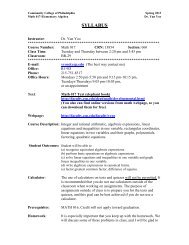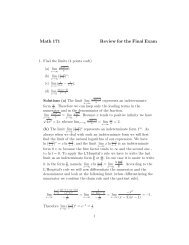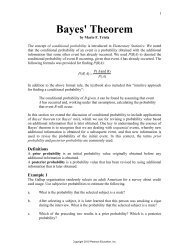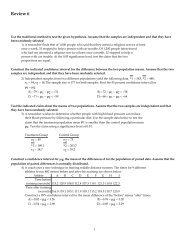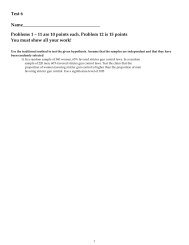Spark Plug Faces - Part 1
Spark Plug Faces - Part 1
Spark Plug Faces - Part 1
You also want an ePaper? Increase the reach of your titles
YUMPU automatically turns print PDFs into web optimized ePapers that Google loves.
<strong>Spark</strong> <strong>Plug</strong> <strong>Faces</strong> - <strong>Part</strong> 1<br />
1. Normal condition<br />
Insulator nose grayish-white or grayish-yellow<br />
to brown. Engine is in order. Heat range of plug<br />
correct.<br />
1<br />
Mixture setting and ignition timing are correct,<br />
no misfiring, cold-starting device functioning. No<br />
deposits from fuel additives containing lead or<br />
from alloying constituents in the engine oil. No<br />
overheating.<br />
2. Sooted — Carbon-fouled<br />
Insulator nose, electrodes and spark plug<br />
shell covered with velvet-like dull black soot<br />
deposits.<br />
Cause: Incorrect mixture setting (carburetor<br />
fuel injection); mixture too rich, air filter very<br />
dirty, automatic choke not in order or manual<br />
choke pulled too long, mainly short-distance<br />
driving, spark plug too cold, heat-range code<br />
number too low.<br />
Effects: Misfiring, difficult cold-starting.<br />
Remedy: Adjust A/F mixture and choke<br />
device, check air filter.<br />
2<br />
3. Oil-fouled<br />
Insulator nose, electrodes and spark-plug<br />
shell covered with shiny soot or carbon<br />
residues.<br />
Cause: Too much oil in combustion chamber.<br />
Oil level too high, badly worn piston rings,<br />
cylinders and valve guides. In two-stroke<br />
engines, too much oil in mixture.<br />
Effects: Misfiring, difficult starting.<br />
Remedy: Overhaul engine, adjust oil/fuel ratio<br />
(2-stroke engines), fit new spark plugs.<br />
3<br />
4. Lead fouling<br />
Insulator nose covered in places with<br />
brown/yellow glazing, which can have a<br />
greenish color.<br />
Cause: Lead additives in fuel. Glazing<br />
results from high engine loading after extended<br />
part-load operation.<br />
Effects: At high loads, the glazing becomes<br />
conductive and causes misfiring.<br />
Remedy: Fit new spark plugs since cleaning<br />
the old one is pointless.<br />
4
<strong>Spark</strong> <strong>Plug</strong> <strong>Faces</strong> - <strong>Part</strong> 2<br />
5. Pronounced lead fouling<br />
Insulator nose covered in places with thick<br />
brown/yellow glazing, which can have a<br />
greenish color.<br />
Cause: Lead additives in fuel. Glazing results<br />
from high engine loading after extended partload<br />
operation.<br />
Effects: At high loads the glazing becomes<br />
conductive and causes misfiring.<br />
Remedy: Fit new spark plugs since cleaning<br />
the old ones is pointless.<br />
5<br />
6. Formation of ash<br />
Heavy ash deposits on the insulator nose<br />
resulting from oil and fuel additives, in the<br />
scavening area and on the ground electrode.<br />
The structure of the ash is loose to cinder-like.<br />
Cause: Alloying constituents, particularly from<br />
engine oil, can deposit this ash in the combustion<br />
chamber and on the spark-plug face.<br />
Effects: Can lead to auto-ignition with loss of<br />
power and possible engine damage.<br />
Remedy: Repair the engine. Fit new spark plugs.<br />
Possibly change engine-oil type.<br />
6<br />
7. Center electrode covered with melted<br />
deposits<br />
Melted deposits on center electrode. Insulator tip<br />
blistered, spongy and soft.<br />
Cause: Overheating caused by auto-ignition. For<br />
instance, due to ignition being too far advanced,<br />
combustion deposits in the combustion chamber,<br />
defective values, defective ignition distributor,<br />
poor-quality fuel. Possibly, spark-plug heat-range<br />
value is too low.<br />
Effects: Misfiring, loss of power (engine damage).<br />
Remedy: Check the engine, ignition and mixtureformation<br />
system. Fit new spark plugs with correct<br />
heat-range code number.<br />
8. <strong>Part</strong>ially melted center electrode<br />
Center electrode has melted and ground electrode<br />
is severely damaged.<br />
Cause: Overheating caused by auto-ignition. For<br />
instance, due to ignition being too far advanced,<br />
combustion deposits in the combustion chamber,<br />
defective values, defective ignition distributor,<br />
poor-quality fuel.<br />
Effects: Misfiring, loss of power (engine damage).<br />
Insulator-nose fracture, possibly due to overheated<br />
center electrode.<br />
Remedy: Check the engine, ignition and<br />
mixture-formation system. Fit new spark plugs.<br />
7<br />
8
<strong>Spark</strong> <strong>Plug</strong> <strong>Faces</strong> - <strong>Part</strong> 3<br />
9. <strong>Part</strong>ially melted electrodes<br />
Cauliflower-like appearance of the electrodes.<br />
Possible deposit of materials not originating from<br />
the spark plug.<br />
Cause: Overheating caused by auto-ignition.<br />
For instance, due to ignition being too far advanced,<br />
combustion deposits in the combustion chamber,<br />
defective values, defective ignition distributor,<br />
poor-quality fuel.<br />
Effects: Power loss becomes noticeable before total<br />
failure occurs (engine damage).<br />
Remedy: Check engine and mixture-formation<br />
system. Fit new spark plugs.<br />
10. Heavy wear on center electrode<br />
Cause: <strong>Spark</strong> plug exchange interval has<br />
been exceeded.<br />
Effects: Misfiring, particularly during acceleration<br />
(ignition voltage no longer sufficient for the large<br />
electrode gap). Poor starting.<br />
Remedy: Fit new spark plugs.<br />
9<br />
10<br />
11. Heavy wear on ground electrode<br />
Cause: Aggressive fuel and oil additives.<br />
Unfavorable flow conditions in combustion<br />
chambe, possibly as a result of combustion<br />
deposits. Engine knock. Overheating has not<br />
taken place.<br />
Effects: Misfiring, particularly during acceleration<br />
(ignition voltage no longer sufficient for the large<br />
electrode gap). Poor starting.<br />
Remedy: Fit new spark plugs.<br />
11<br />
12. Insulator-nose fracture<br />
Cause: Mechanical damage (spark plug has<br />
been dropped or bad handling has put pressure<br />
on the center electrode). In exceptional cases,<br />
deposits between the insulator nose and the<br />
center electrode, as well as center-electrode<br />
corrosion, can cause the insulator nose to<br />
fracture (this applies particularly fro excessively<br />
long periods of use).<br />
Effects: Misfiring, spark arcs-over at a point<br />
that is inaccessible for the fresh charge of A/F<br />
mixture.<br />
Remedy: Fit new spark plugs.<br />
12



